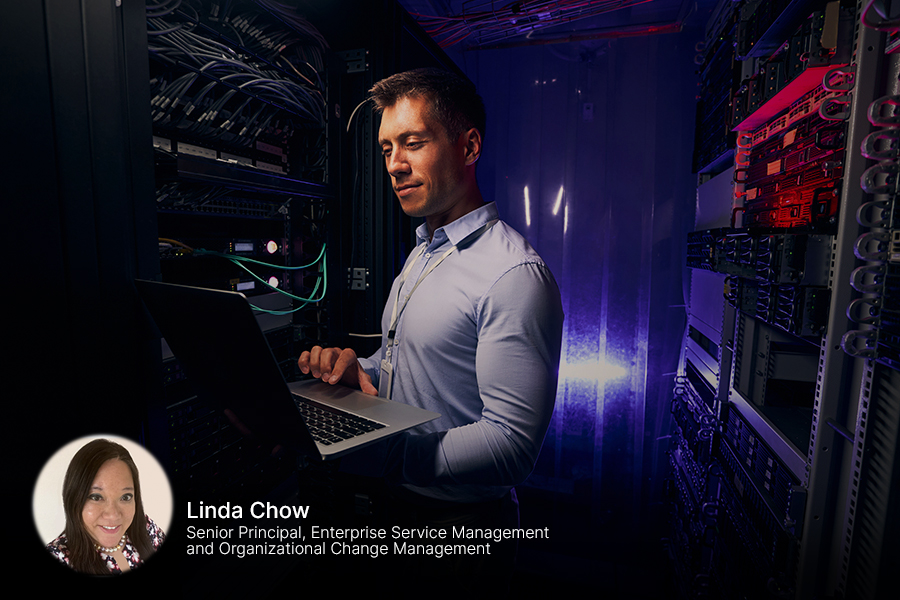Migrating from Remedyforce is critical for organizations still using this IT service management platform. As Remedyforce approaches its end-of-life date in 2026, a seamless transition is essential to avoid downtime and ensure continued success for your IT operations. In this blog, Linda Chow discusses the need to migrate from Remedyforce and offers tips and strategies for a successful migration.
As Remedyforce approaches its end-of-life date in 2026, organizations still using this IT service management platform must consider migrating to a new platform to avoid potential consequences such as data loss and downtime. The responsibility of selecting a new ITSM application to replace Remedyforce lies with you, and a deadline is approaching. Lots of questions surround this decision. Which is the right ITSM platform for your organization? How can you maximize the delivery of IT services to your customers? Developing a service management roadmap helps crystallize organizational priorities, drive alignment, and communicate a unified plan.
The Benefits of an IT Service Management Vision Strategy
An ITSM vision strategy documents a long-term plan and roadmap, including specific goals and responsibilities. The vision strategy is a singular framework with defined activities and projects, ensuring the enterprise resources have common objectives and plans. A well-defined ITSM platform strategy enables organizations to manage their IT services effectively by optimizing people, processes, and technology. This also allows organizations to improve service quality, reduce costs, and enhance customer satisfaction. Having an IT Service Management vision strategy will aid and support the IT team in explaining and defending the costs required to perform the service management strategy plans. Furthermore, by outlining high-level phases and necessary actions, an IT department may find it easier to earn approval from impacted departments.
Without proper planning, enterprises might invest in an inadequate service management platform, leading to financial, operational, and demand consequences. Implementing a flawed service management application can result in delayed business application responses, data loss, and downtime. In a worst-case scenario, buying a second service management application may be necessary, multiplying cost investment and duplicating work efforts and resources.
Define the Requirements: People, Process, and Technology
The first step in defining an ITSM vision strategy is defining the enterprise’s requirements. Begin by outlining the requirements and prerequisites for a new ITSM tool platform across people, process, and technology categories. Then, use those criteria to evaluate and match the most suitable and fitting target ITSM application for migration. Additionally, develop and document the requirements, including business reasons, operational justification, funding, sizing, and timeline. Specific to people, processes, and technology, define the criteria, conditions, constraints, and demands of the organization and technology to ensure sufficient service delivery.
People Requirements
- Process Requirements
Include in the strategy individuals that plan, design, deliver, consume, operate, and manage service delivery and infrastructure through the service management tool. Take the following considerations into account when developing a plan:
Outline steps for planning, designing, delivering, operating, and controlling applications and infrastructure to understand the process requirements clearly. To help ensure a successful process and delivery of your services, include the following items:
- Hierarchy. Are organizational structures of teams, roles, and responsibilities set up to enable value creation? Can each activity be mapped to a role? What is the approval process?
- Governance. Which governance structures are required? Do they balance flexibility with risk?
- Communication. How will you communicate value and service delivery expectations across the organization? What is the potential impact of poor communication? Which collaboration tools enable consistent contact across distributed teams?
- Roles and Training. Which roles (and how many) will each service management function require? What are the training requirements, timelines, and schedules? Will training be on-demand or in-person?
- Current State. Catalog all existing service management processes in the present landscape to determine which areas are working and which need improvement.
- Target State. Identify and formalize new service management processes, areas, and process requirements.
- Prioritize Critical Processes. Sequence the implementation of essential processes based on the needs of the enterprise and business unit.
Technology Requirements
When creating a well-rounded migration plan, it’s essential to consider the following technology requirements:
- IT Service Management: incident, change, problem, knowledge, configuration, and service catalog management
- IT Operations Management: service mapping, event management, and configuration management database (CMDB) discovery
- Service Portfolio Management: demand, project, and resource management
- IT Asset Management: hardware and software management
- Integration: Active Directory, LDAP, single sign-on (SSO), HR applications (e.g. Workday), and IaaS (e.g. Azure, GCP, and AWS)
- Metrics and Dashboard: key performance indicators (KPIs), service level agreements (SLAs), and customer satisfaction surveys
For IT resource requests, consider rollouts and rollbacks, service discovery and load balancing, horizontal scaling, recovery (including self-healing, dynamic discovery, and automated rollbacks), compliance checks, data backup, and integration into the ITSM platform. Monitor availability, performance, response time, latency, and error rate, and integrate monitoring with event management for increased uptime. Automate processes to free up human agents, provide self-service options for consumers and establish a self-reliant self-service value chain.
Select the Appropriate Target IT Service Management Application
Compare, evaluate, and analyze your options to choose the most suitable ITSM platform to meet your enterprise’s requirements. Then, use quantitative and calculable logic to select the target ITSM platform that meets all or most people, processes, and technology requirements.


Create an ITSM Vision Roadmap and Migration Plan for End-of-Life Platforms
Once you have defined your critical ITSM requirements and selected a new target application, create a vision and roadmap. This roadmap should cover a time span of two to three years and highlight significant milestones for each quarter and year-end. In addition to outlining the roadmap, it’s critical to include a plan for migrating data from the existing ITSM platform to the new ITSM platform. Finally, consider retiring and decommissioning defunct or obsolete software and infrastructure to avoid unnecessary expenses and complexity.




